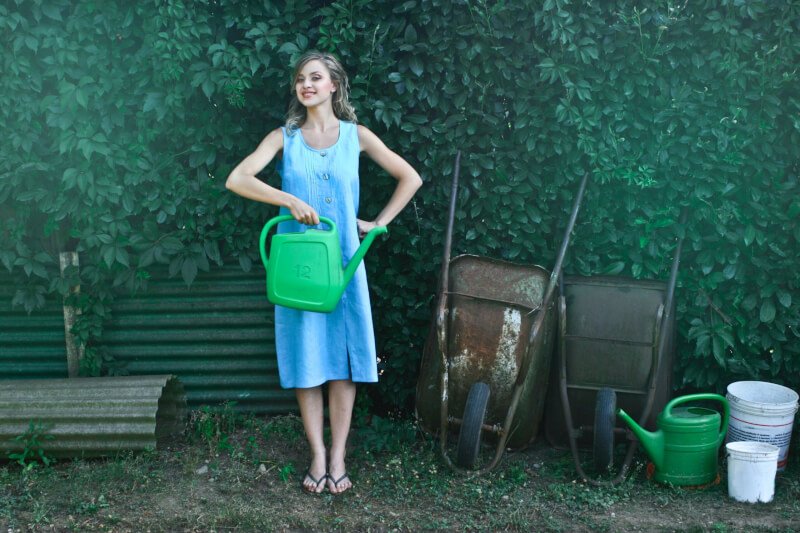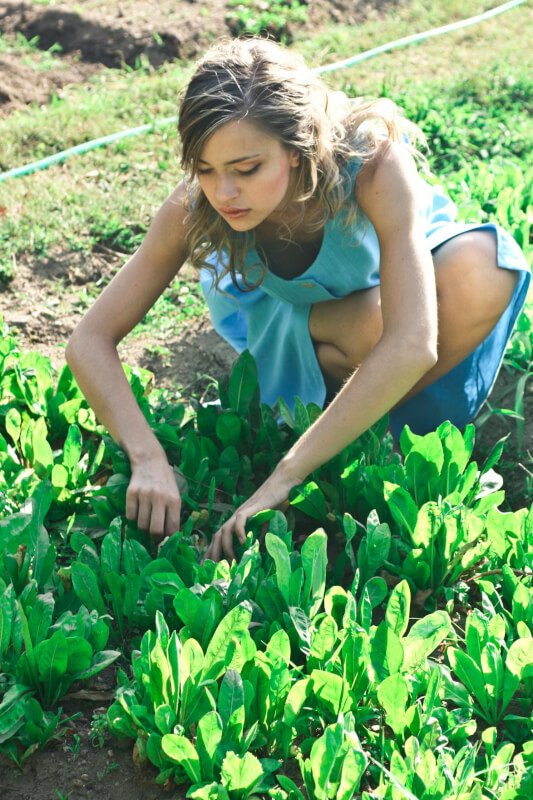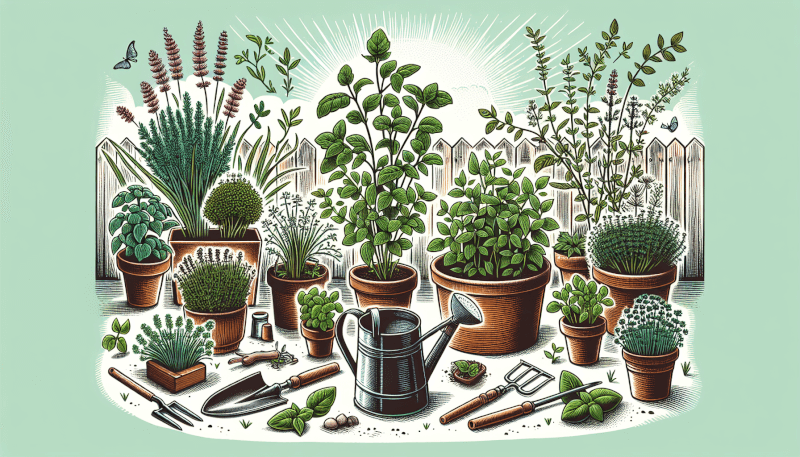Are you tired of buying expensive herbs from the grocery store every time you want to add some flavor to your cooking? Look no further! This beginner’s guide is here to help you take the first steps towards growing your own herbs for cooking. Whether you have a spacious garden or just a small balcony, you’ll discover simple and practical tips on how to cultivate a variety of herbs, right at your fingertips. From choosing the right herbs to understanding their basic care needs, this guide will equip you with all the knowledge you need to start your very own herb garden and elevate your culinary creations to a whole new level. So dust off that gardening hat and get ready to embark on an exciting herb-growing adventure!

Choosing the Right Herbs
When it comes to growing your own herbs for cooking, the first step is choosing the right ones for your culinary adventures. Consider your cooking style and the dishes you enjoy making the most. Do you prefer Italian cuisines with a lot of basil and oregano, or do you lean towards Asian flavors with a focus on cilantro and Thai basil? Understanding your cooking style will help you choose herbs that complement your favorite dishes.
As a beginner, it’s recommended to start with easy-to-grow herbs. These herbs are more forgiving and require minimal effort to thrive. Some popular choices for beginners include basil, parsley, chives, mint, and thyme. These herbs are not only versatile in cooking but also relatively low-maintenance, making them perfect for those starting their herb garden journey.
Before diving into growing a particular herb, it’s essential to research its growth requirements. Different herbs have varying needs when it comes to sunlight, water, and soil conditions. Some herbs, like rosemary and lavender, thrive in full sunlight and dry soil, while others, like parsley and cilantro, prefer partially shaded areas with moist soil. Knowing these details will help you create an ideal growing environment for each herb, ensuring their health and flavor.
Deciding on the Growing Medium
Once you’ve chosen the herbs you want to grow, the next step is deciding on the growing medium. There are a few options to consider, depending on your circumstances and preference.
Container gardening is an excellent choice for those with limited space or no access to a garden. By using pots or planters, you can create a portable herb garden. Ensure the containers have drainage holes to prevent waterlogging and choose a potting mix specifically designed for container gardening. These mixes typically provide excellent drainage and aeration, promoting healthy root growth.
If you have access to a garden area or larger outdoor space, you can also grow herbs directly in the soil. In this case, choose a well-draining soil that is rich in organic matter. Amending the soil with compost or aged manure will help improve its fertility and structure, providing a healthy growing environment for your herbs.
For those who enjoy experimenting with innovative gardening techniques, hydroponics is a fascinating option. Hydroponic systems allow you to grow herbs without soil, using nutrient-rich water to nourish the plants. This method requires some initial investment in equipment and setup, but it can produce high yields and allows for year-round herb cultivation.
Selecting the Right Location
Herbs have specific requirements when it comes to their growing environment, particularly sunlight and air circulation. It’s crucial to assess the sunlight requirements of the herbs you’ve chosen. Some herbs, like basil, need at least six hours of direct sunlight daily, while others, like mint, can tolerate partial shade. Take note of the sunniest spots in your garden or indoor space and position your herbs accordingly.
When deciding between indoor and outdoor gardening, consider the advantages and limitations of each. Indoor gardening allows you to have fresh herbs close at hand, even in small living spaces. However, it requires adequate light, either from natural sources or grow lights. Outdoor gardening, on the other hand, provides ample sunlight and natural airflow but may be limited by climate or lack of space.
Proper air circulation is crucial for the health and vitality of your herbs. Good airflow helps prevent fungal diseases and keeps pests at bay. If you’re growing herbs indoors, place them in an area with good ventilation. When growing outside, be mindful of planting herbs too close together, as overcrowding can inhibit air circulation.
Sourcing Herb Seeds or Seedlings
When it comes to obtaining the plants for your herb garden, you have two main options: seeds or seedlings. Choosing between these depends on your preference and the time you’re willing to invest.
Starting from seeds allows you to experience the full journey of cultivation, from germination to harvest. It can be a rewarding experience to witness the growth of your herbs from tiny seeds. Seeds are readily available in local garden centers, nurseries, and online sources. They also tend to be more affordable than purchasing seedlings.
If you’re looking for a head start and prefer to skip the germination process, purchasing seedlings is a convenient option. Local nurseries and garden centers often stock a variety of herb seedlings during the growing season. They will have already passed the delicate germination stage and are ready to be transplanted into your garden or containers.
Another option is to utilize online sources and catalogs. Many reputable online seed companies offer a wide selection of herb seeds and seedlings. This option allows you to explore a broader range of herb varieties and often provides detailed information on each herb’s growth requirements.

Preparing the Soil or Growing Medium
Whether you choose to garden in containers, in the soil, or via hydroponics, preparing the soil or growing medium is essential to ensure the health and productivity of your herbs.
If you’re growing herbs in the soil, it’s a good practice to amend it with organic matter before planting. This helps improve its fertility, water retention, and overall structure. Adding compost, well-rotted manure, or other organic materials to the soil will provide essential nutrients to your herbs as they grow.
For container gardening, ensure proper drainage by placing rocks or broken pottery shards at the bottom of your pots or using containers with drainage holes. This prevents water from accumulating at the roots, which can lead to root rot or other diseases. Additionally, choose a high-quality potting mix specifically formulated for containers. These mixes often have excellent drainage properties and provide the necessary nutrients herbs need.
If you’ve opted for hydroponics, prepare the hydroponic system according to the manufacturer’s instructions. This usually involves setting up the water reservoir, inserting growing trays or pots, and connecting the irrigation system. Ensure that the water and nutrient levels in the system are properly adjusted before introducing your herb plants.
Planting and Transplanting Herbs
Now that your growing medium is ready, it’s time to plant or transplant your herbs. The process may vary slightly depending on whether you’re starting from seeds or transferring seedlings or established plants.
When starting from seeds, it’s often best to begin indoors. Fill seed trays or pots with a seed-starting mix, plant the seeds according to the packet instructions, and lightly cover them with soil. Place the trays in a warm, sunny location, or use heat mats to aid germination. Once the seedlings have grown a few sets of true leaves and all danger of frost has passed, they can be transplanted into their permanent containers or garden beds.
If you’ve chosen seedlings or established plants, gently remove them from their nursery pots and loosen the roots before planting them in the soil or containers. Follow proper spacing guidelines to allow ample room for growth and prevent overcrowding, which can lead to competition for resources and increased susceptibility to diseases.

Providing Proper Care and Maintenance
Maintaining the proper care for your herbs is crucial to their continued growth and productivity. Here are some important aspects to consider:
Watering guidelines: Herbs have varying water requirements, but most prefer to be kept moist rather than saturated. Regularly check the moisture level of the soil or growing medium and water accordingly, ensuring it doesn’t dry out completely. Avoid overwatering, as this can lead to root rot and other issues.
Fertilizing herbs: To promote healthy growth, it’s beneficial to fertilize your herbs regularly. Choose a balanced, water-soluble fertilizer specifically formulated for herbs or vegetables. Follow the instructions on the package to determine the proper dilution and frequency of application. Organic alternatives, such as compost tea or seaweed extract, can also provide a nutrient boost to your herbs.
Pruning and harvesting techniques: Regular pruning not only helps shape your herb plants but also encourages bushier growth. Remove any damaged or unhealthy leaves or stems to maintain plant health. When harvesting herbs, cut the stems just above a leaf node to encourage further growth. It’s important to avoid harvesting more than one-third of the plant at a time to ensure its vitality.
Preventing and Managing Pests and Diseases
Despite your best efforts, herbs can still fall victim to pests and diseases. It’s essential to stay vigilant and take preventative measures to keep your herb garden healthy.
Identify common herb pests: Familiarize yourself with common herb pests such as aphids, whiteflies, and snails. Regularly inspect your plants for signs of infestation, including visible pests, discolored leaves, or sticky residue on the leaves. Early detection is key to preventing an infestation from spreading.
Implement natural pest control methods: Whenever possible, opt for organic and natural pest control methods. For example, you can introduce beneficial insects like ladybugs or lacewings to prey on aphids and other pests. Homemade remedies, such as garlic or chili pepper sprays, can also help deter pests without the use of harmful chemicals.
Recognize and treat common herb diseases: Diseases like powdery mildew and root rot can affect herbs if conditions are unfavorable. Proper air circulation, well-draining soil, and avoiding overwatering can help prevent such diseases. If your herbs do develop a disease, promptly identify the issue and treat it accordingly. Organic treatments, such as neem oil or baking soda solutions, can often be effective in controlling certain plant diseases.

Harvesting and Preserving Herbs
One of the most rewarding aspects of growing your own herbs is being able to harvest and enjoy them in your cooking. Here are some tips to ensure a successful harvest and proper preservation of your herbs:
Timing the harvest: Each herb has its own ideal time for harvest, depending on the growth stage and desired flavor. Generally, herbs are at their peak flavor just before they start flowering. Regularly check your herbs and harvest them when the leaves are young and vibrant.
Proper techniques for cutting herbs: When harvesting, use sharp, clean scissors or pruning shears to make clean cuts. Harvesting in the morning, after the dew has dried, can help preserve the flavor and aroma of the herbs. Cut the stems just above a leaf node to encourage bushier growth and avoid exposing bare stems.
Storing and preserving harvested herbs: To prolong the shelf life of your harvested herbs, it’s essential to handle them properly. Rinse the herbs gently with water to remove any dirt or insects, and pat them dry with a clean towel. Depending on the herb, you can store them in refrigerated containers, wrapped in damp paper towels, or air-dry them for long-term preservation. Freezing herbs in ice cube trays with a little water or oil can also maintain their flavor for future use.
Using your Homegrown Herbs in Cooking
Finally, the moment you’ve been waiting for – using your homegrown herbs in your culinary creations! Here are some tips to make the most of your herb garden in the kitchen:
Experimenting with different recipes: Don’t be afraid to get creative and try out different recipes using your homegrown herbs. Whether it’s using basil in a homemade pesto, cilantro in a fresh salsa, or rosemary in a roasted chicken dish, herbs can elevate the flavor of your dishes and add a unique touch.
Understanding the flavor profiles of herbs: Each herb has its own distinct flavor profile, ranging from sweet and floral to spicy and earthy. Take the time to familiarize yourself with the flavors of the herbs you’ve chosen to grow. This knowledge will help you pair them effectively with different ingredients and create harmonious flavor combinations.
Properly pairing herbs with different dishes: Experiment with pairing herbs with different dishes to enhance their flavors. For example, mint works beautifully in salads and desserts, while thyme adds depth to savory meat dishes. Don’t be afraid to trust your taste buds and explore new combinations to find your favorite herb and food pairings.
By following these steps and investing a little time and effort, growing your own herbs for cooking can be a rewarding and enjoyable experience. Not only will you have a constant supply of fresh, flavorful herbs at your fingertips, but you’ll also have the satisfaction of knowing you’ve nurtured and cared for your own culinary garden. Happy herb gardening!


